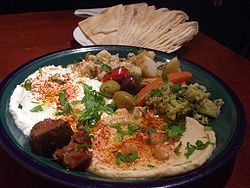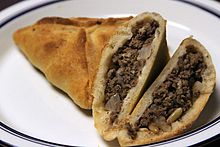- Middle-Eastern cuisine
-
Middle-Eastern cuisine, West Asian cuisine, or in some place in the United States, Persian-Mediterranean cuisine is the cuisine of the various countries and peoples of the Middle East (Western Asia). The cuisine of the region is diverse while having a degree of homogeneity.[1] Some commonly used ingredients include olives and olive oil, pitas, honey, sesame seeds, dates,[1] sumac, chickpeas, mint and parsley. Some popular dishes include kibbeh and shawarma.
Contents
Elements
Many Middle-Eastern dishes are made with a paste called tahini. Tahini is a sesame paste made with hulled seeds, unlike its Asian counterpart. It is used to make such popular meze, or appetizers, as baba ghanoush and hummus along with pungent dipping sauces served with falafel, keftes or kofta and vegetables.[2] Hummus is made from chickpeas, which are staples of the diet.
History and influences
The Middle East was where wheat was first cultivated, followed by barley, pistachios, figs, pomegranates, dates and other regional staples. Fermentation was also discovered here to leaven bread and make beer. As a crossroads between Europe, Asia and Africa, this area has long been a hub of food and recipe exchange. During the Persian Empire (ca. 550–330 BCE) the foundation was laid for Middle-Eastern food when rice, poultry and fruits were incorporated into their diets. Figs, dates and nuts were brought by Arabian warriors to conquered lands.
The area was also influenced by dumplings from Mongol invaders; turmeric, cumin, garlic and other spices from India; cloves, peppercorns and allspice from the Spice Islands[disambiguation needed
 ]; okra from Africa; and tomatoes from the New World, via the Moors of Spain. Religion has also changed the cuisine as neither Jews nor Muslims eat pork, making lamb the primary meat. Since the Qur'an forbids alcohol consumption, the region isn't noted much for its wine.[1][3]
]; okra from Africa; and tomatoes from the New World, via the Moors of Spain. Religion has also changed the cuisine as neither Jews nor Muslims eat pork, making lamb the primary meat. Since the Qur'an forbids alcohol consumption, the region isn't noted much for its wine.[1][3]During Turkey's Ottoman Empire the sweet pastries of paper thin phyllo dough and the dense, sweet coffee was brought to the area; coffee is now consumed throughout the Middle East.
Beverages
Aside from the ever-popular Middle-Eastern coffee, there is also an alcoholic drink called arak. Arak has a high alcohol content, so water and ice is almost always added, producing the drink nicknamed "the milk of lions."[4]
Etiquette
In some areas in the Middle East, it is common for people to take their food from a common plate in the center of the table. Rather than employing forks or spoons, people may scoop up hummus and other foodstuff with pita bread. Among Muslims in particular, the left hand is reserved for bodily hygiene and considered unclean. Thus, the right hand should be used for eating; shaking hands or handing over an item with one's left hand is an insult.
Geographical varieties
 Armenian cuisine
Armenian cuisine Azerbaijani cuisine
Azerbaijani cuisine Assyrian cuisine
Assyrian cuisine Bahraini cuisine
Bahraini cuisine Cypriot cuisine
Cypriot cuisine Emirati cuisine
Emirati cuisine Georgian cuisine
Georgian cuisine Irani cuisine
Irani cuisine Iraqi cuisine
Iraqi cuisine Israeli cuisine
Israeli cuisine Jordanian cuisine
Jordanian cuisine Kurdish cuisine
Kurdish cuisine Kuwaiti cuisine
Kuwaiti cuisine Egyptian cuisine
Egyptian cuisine Lebanese cuisine
Lebanese cuisine Omani cuisine
Omani cuisine Palestinian cuisine
Palestinian cuisine Saudi Arabian cuisine
Saudi Arabian cuisine Syrian cuisine
Syrian cuisine Turkish cuisine
Turkish cuisine Yemeni cuisine
Yemeni cuisine
See also
References
- ^ a b c "The Middle East: Background.", Globalgourmet.com. Accessed January 2007.
- ^ Tahini: The Taste of Healthy Middle Eastern Cuisine, The New York Times, October 19, 2009. Last visited January 29, 2010.
- ^ Middle Eastern cuisines: gain ground, Bnet UK, January 2003
- ^ Arak: Middle Eastern Alcoholic Beverage, About.com,
Categories:- Middle Eastern cuisine
- Cuisine by continent
Wikimedia Foundation. 2010.



